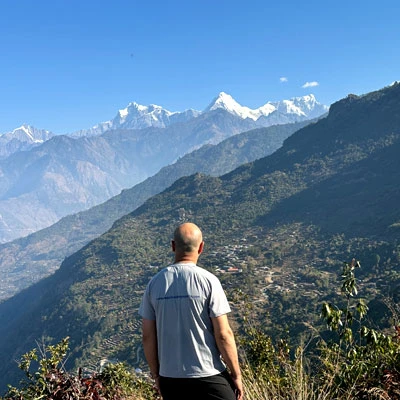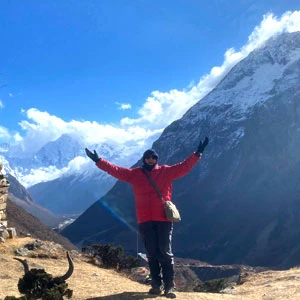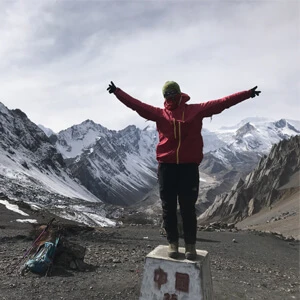Allure And Isolation Of Nar Phu Valley
The Nar Phu Valley lies high in the rain shadow of the Annapurna range, just northeast of the classic Annapurna Circuit. It borders the edge of Tibet and is left untouched by the fast pace of modern trekking tourism. From the moment I stepped beyond the checkpoint at Koto, I felt like I had crossed into a different dimension.
During this trek, I was left in near-complete solitude as I went days without seeing another trekker. The narrow trails wound through gorges, past landslide-prone slopes, and into windswept highlands, entering the villages with stone-built settlements.
Moreover, the cultural depth of the valley is as breathtaking as its peaks. I passed through centuries-old Tibetan Buddhist monasteries, watched yak herders navigate trails, and shared salt-butter tea with locals. It felt like a privilege to simply be there.
While the Nar Phu stood so magical, it also was mentally and physically demanding. There is no safety net, no nearby help, no bustling teahouse to retreat to. Just you, your team, the trail, and the wild.
Challenges During The Trek
Daily Walking Hours
One of the first things that hit me on the Nar Phu Valley trek was the sheer number of hours I had to keep moving each day. I trekked for six to nine hours daily, often on steep, unforgiving terrain. Some days stretched even longer, especially when crossing high ridges or navigating washed-out trails.
Elevation Gain & Altitude
From the very beginning, the Nar Phu Valley Trek hit high and stayed high. Most of the days were spent well above 2,500 meters, and as the trail climbed deeper into the Himalayas, the air grew noticeably thinner.
At first, the altitude felt subtle with just a little shortness of breath on the steeper climbs. But as I pushed higher, especially beyond 3,500 meters, every step started to demand more from my lungs, my legs, and my mental grit.
What made it especially tough was the consistent elevation gain as the trail doesn’t offer many low-altitude breaks. The climb to Phu felt long and relentless, and by the time I reached the high pass of Kang La (5,320 meters), I could feel my heart working overtime even during short rests.
Terrain & Trail Conditions
During the trek to Nar Phu Valley, I walked through narrow trails hugging cliff sides, winding ascents, and dry riverbeds. The landscape is quite diverse presenting new paths every hour or so.
Likewise, the high passes were another beast entirely: wind-blasted, steep, and often covered in snow or ice depending on the season. On top of it, a wrong step could lead to injury which in different places may be minor but in this remote region, it could create trouble as immediate help would be difficult.
Hence, this trek forced me to be present and alert. I was moving mindfully and respected every twist in the trail.
Crossing Kang La Pass
The Kang La Pass at 5,320 meters was the final boss of this trek. I still remember waking up in Nar well before dawn to accomplish this summit. Even the initial climb to the pass started steep and it only got steeper, with every step.
The trail didn’t give any breaks. It just kept climbing, switchback after switchback, over loose rocks, across icy patches, and through biting gusts. At that altitude, even pausing to catch my breath felt like work.
But standing on top of the pass greeted me with a panoramic reward: a sweeping view of the Annapurna range.
Logistics & Amenities
The tea houses along the route of Nar Phu Valley were humble, often just stone structures with drafty rooms, shared squat toilets, and solar-powered lights. The rooms did not have heating and hence, I heavily relied on my sleeping bag. Likewise, the menus were limited to dal bhat, instant noodles, and the occasional pancake.
Additionally, there was no mobile network for most of the trek. Altogether, this trek does not pamper you but feeds you authenticity in trade for comfort.
Weather Condition
Even during the ideal trekking seasons, I faced everything from warm sunshine to biting wind, and even a surprise snowfall: all in a single day. At times, mornings often began with blue skies and golden light. But by afternoon, the mood could shift in an instant, with clouds rolling in and visibility dropping.
Here, the real test came near Kang La Pass, as it was bone-chilling cold. The higher we climbed, the more exposed we were to the elements. Similarly, there were times we had to delay our start or shorten our walking hours simply because the weather refused to cooperate.
Acclimatization & My Strategy
One of the biggest lessons the Nar Phu Valley trek taught me was this: if you don’t respect the altitude, the mountains will humble you fast. With most of the trek spent above 2,500 meters and several days above 4,000, acclimatization wasn’t optional.
I built in extra rest days in both Phu and Nar, and honestly, they were some of the most valuable days of the entire journey. However, despite my precautions, I did get a taste of altitude.
Above 4,500 meters, I started feeling that nagging headache and bone-deep fatigue. It did slow me down and I was double-checking every step I took. To help me from this condition, I hydrated constantly, sometimes even forcing myself to drink when I didn’t feel thirsty.
I also practiced deep breathing techniques during rest stops and took a low dose of Diamox for a couple of days when I felt symptoms linger. Lastly, I kept my pace deliberately slow, taking my time to familiarize my body with the altitude level.
Mental Challenge During The Trek
One thing I hadn’t fully prepared for on the Nar Phu Valley trek was just how quiet the trail would be. This wasn’t the buzzing Everest Base Camp or even the bustling Annapurna Circuit, this was solitude in its purest form.
Some days, we would walk for hours without seeing a single soul outside our small group. NWe would only be accompanied by the sound of my own breathing, boots crunching on gravel, and the occasional gust of wind.
At first, the silence would be therapeutic but over time, my mind slowed down, and I became deeply aware of my surroundings. After a few days, the mental solitude started to weigh in. There were moments where the trail felt endless, and with no one else around, the weight of isolation pressed a little heavier.
Mental endurance became just as important as physical stamina.
Who Should Trek To Nar Phu Valley?
If you are an experienced trekker who has navigated high-altitude trails before and loved the rawness of remote mountain terrain, then this route might just be your next great adventure. But if you are new to trekking, this trail will chew you up and spit you out, and I say that with full honesty.
This Nar Phu Valley trek calls for solid physical fitness, but more importantly, it requires mental endurance. There are long days of hiking, big altitude gains, and little to no backup if something goes wrong. Likewise, luxury doesn't exist out here. There are no hot showers, no heated dining halls, and no cushy beds.
But I would absolutely recommend this trek, just not to everyone. This trek is for those who want to be humbled, who crave solitude over social scenes, and who are willing to go off-the-grid.
Pro Tips For The Nar Phu Valley Trek
- Make sure to hire a porter to share your load with. Even though you may be physically fit, trekking in such a remote region at such high altitude with a backpack can get challenging.
- Pack smart and light. You should only bring the essential and practical items.
- Dress up in layers to adjust to the changing weather conditions easily. You should have a warm base layer, insulating layer, and waterproof and windproof outer layer.
- Start training for this trek at least 5 to 6 weeks in advance. You should engage yourself in cardio exercises, strength training, and endurance building. It would be more beneficial if you have prior experience in trekking.
- Always look out for regular updates on weather conditions during the trek. It is better to start early to avoid any unpredictable changes in the afternoon.
- Carry all your personal medications and a small first aid box consisting of basic medicines such as blister treatment, Diamox, bandages, and so on.
- Do not skip your rest days. Instead you can follow the “climb high and sleep low” principle.
- Mentally prepare yourself for solitude. You can bring stuff for distractions such as board games, cards, or books.
Conclusion
Was the Nar Phu Valley Trek difficult? Absolutely. There were days when I was exhausted, my lungs burned from the thin air, and I was full of doubts. But was the trek dangerous? It can be only if you are unprepared. With the right gear, a steady pace, and a trusted guide, this journey can be challenging but manageable.
Altogether, this trek reminded me why I hike. For this journey, I took the lead from Nepal Trekking Experts. They took care of my every need during the trek. If you are considering the Nar Phu Valley Trek and want a partner who genuinely knows these mountains, they are the team you want beside you.
FAQs
Where is Nar Phu Valley located?
The Nar Phu Valley lies in the remote northeast of the Annapurna region, close to the Tibetan border.
How long does the trek usually take?
The Nar Phu Valley Trek typically takes around 10 to 14 days, depending on the itinerary and acclimatization stops.
Do I need a special permit for this trek?
Yes, you need a Nar Phu Valley Restricted Area Permit along with Annapurna Conservation Area Permit (ACAP).
Is it possible to do this trek without a guide?
No, trekking in Nar Phu Valley without a guide is not allowed due to restricted area regulations.
What is the best time to do the Nar Phu Valley Trek?
Spring (March to May) and Autumn (September to November) are the ideal trekking seasons as they offer the best weather conditions.
How high is the Kang La Pass?
Kang La Pass stands at about 5,306 meters (17,408 feet).
Is the trek suitable for beginners?
No, it’s better suited for trekkers with prior high-altitude experience and good fitness.
Is there mobile network or internet access along the route of Nar Phu Valley?
Most of the route has no connectivity but you may get the connection at the beginning or end of the trek.
Can I suffer from altitude sickness during this trek?
Yes, as most of the trek is above 2,500 meters, proper acclimatization is essential.
Is travel insurance necessary?
Absolutely. You need travel insurance for the trek to Nar Phu Valley that covers high-altitude trekking and emergency evacuation.
What physical preparation should I do?
You should start with cardio and strength training for this trek at least 5 to 6 weeks prior to the journey.
.webp)






